On the heels of the World Health Organization’s declaration of the Wuhan coronavirus as a global emergency, some of the world’s largest trade shows have been disrupted. Sponsors and attendees alike are downgrading or withdrawing their participation, prompting event organizers to postpone and even cancel their events. Stated communications service provider Ericsson upon its withdrawal from the 2020 Mobile World Conference, “Ericsson appreciates that GSMA have done everything they can to control the risk. However, as one of the largest exhibitors, Ericsson has thousands of visitors in its hall each day and even if the risk is low, the company cannot guarantee the health and safety of its employees and visitors.”
One way event planners can guarantee the health and safety of employees and visitors: a virtual event platform. A virtual event is like a live trade show, except as the name implies, it takes place virtually, or online. Going beyond just a webinar, the technology allows individual users and businesses to enter a virtual, accessible 3D event space, where attendees can visit trade show booths, watch live webcasts, and interact with each other in chat rooms (complete with translations if necessary). They can download product sheets, presentations, and videos… at approximately 75% less than the cost of live attendance and all without the hassle of airport security, hotel check-in lines, or in the case of today’s headlines – the risk of contagion.

Even better for those companies leveraging trade shows to identify the almighty lead: virtual event visitors’ behavior is tracked, analyzed, and visualized, allowing companies to truly understand who their potential buyers are and where they may be in the buying cycle. Added bonus: these leads are available in perpetuity. With a virtual event, companies have the ability to create new sales over and over. Once they’ve built the event, they never have to break it down. They can keep using it over and over again. They’ve now established a new community.
Additional benefits include:
Wide Reach: Everyone can attend an online event, irrespective of their location. A virtual event is a great opportunity to connect with a wider, international audience and make connections with peers, prospects, and experts with whom attendees might not have crossed paths at a physical event.
Companies can also expand their reach by offering both a physical and an online experience, or a “hybrid” event. Hybrid events often draw a larger crowd, and in a hybrid event, there are more voices in the dialogue. For example, the virtual moderator can lead discussions on social media or the event platform during the event as well as interact with the live audience during a break.
And in the case of the unexpected, such as a virus outbreak, a hybrid event allows companies to choose how they would like their employees to experience the event’s content, networking opportunities, and product demonstrations. For those companies who prefer a face-to-face experience and feel comfortable allowing employees to travel, the opportunity is there. And for companies like Ericsson, who are unwilling to allow employees to travel amidst virus concerns, there’s no need to forego participation.
Cost-Effectiveness: Physical events come with a laundry list of expenses: venue rental, staff, travel, food, hotels, and entertainment. A virtual event eliminates many of these line items, not to mention speakers often charge less and registration numbers increase because everyone on a global team can attend.
Low Carbon Footprint: Compared to traditional trade shows, virtual trade shows are “greener,” and lowering environmental impact is an increasingly important goal for many companies, especially in a world where consumer buying groups are making purchasing decisions based on a company’s commitment to the environment. Tax incentives for cutting fuel costs are also likely to increase, making virtual exhibits an even more attractive proposition.
Intelligent Lead Generation: Traditional trade shows often generate exciting leads. Unfortunately, 80% of those leads are never contacted again – a statistic bound to discourage the most enthusiastic marketing professional. The reasons are myriad: disconnects between marketing and sales departments, the difficulties of reading hand-scribbled names and addresses, the tedium of entering contact information by hand into databases. However, virtual trade shows assume responsibility for collecting the data – and most include built-in lead management software. Suddenly tracking leads becomes simple. In addition, many systems offer tags so sales reps can make notes on attendees or companies, making post-event contact easy.
Also, virtual event systems generally allow companies to run analytics as soon as the show is complete. Instead of entering all of the data separately, the virtual trade show tracks and analyzes it and generates reports. Sales can chase leads immediately, which can greatly improve return on investment.
Opportunities to Connect with Next Generation Buyers: Virtual events help companies connect with the digital generation. Over time, the digital generation will comprise the majority of corporate decision makers, and this generation will be at least as comfortable with the virtual world as they are with text on a page. Gaining experience now in the virtual world will give companies an edge in marketing to this vast demographic.
Productivity: When an employee is at a trade show,he or she is out of pocket. Valuable time is spent traveling and attending the event itself. And for event sponsors, let’s face it: just putting up and taking down a booth can be a day’s work in itself. A virtual event, however, allows the employee to visit and revisit the experience on their own terms, increasing the attendee’s productivity, the conference’s value for the attendee, and its ROI for the event producer. And virtual events tend to be faster paced than those in real life since the attendees don’t have to physically move from space to space. This means attendees can actually meet more people.
The Search is Over
As companies strive to protect the health and safety of their employees as well as the employees of their customers, partners, and vendors, they’re taking all necessary measures to ensure no one is put at risk: restricting travel, limiting the size of meetings, providing remote-work solutions, and continuing to insist on safe behavior in every environment. One easy and safe way to conduct “business as usual” in this environment is through the use of virtual events. To learn more about how you can leverage virtual event technology in your own organization, request a demo today.
Virtual event planning software is clearly on the rise, with lead generating virtual events consistently proving themselves as the most powerful weapon in the digital marketing arsenal.
With such powerful results, multi-sponsor marketing events that have always been predominantly physical are now turning into virtual summits. Companies are learning how to connect with attendees through virtual booths and sponsored sessions.
But all of this commotion begs the question… what are the real differences between physical and virtual events?
For those of you thinking about replacing a physical event with a virtual event, here is the definitive pro-con list of physical vs. virtual events from the perspective of a virtual event insider.
For visual learners, here is a handy infographic summing it all up. If you need a more elaborate breakdown, scroll down a bit more.
In this section, we are going to breakdown the biggest differences between virtual events and physical events, weighing both the pros and cons of each difference.
One of the best parts of an in-person event is coincidentally one of the most expensive: travel.
Traveling to a new city or stomping ground is exciting and can help employees shake the daily grind, but it is also extremely costly. Costs for physical events include the following:
… you get the picture.
There is definitely something to be said for changing it up and giving attendees a memorable experience in a new city, but it’s going to cost you.
Fortunately, there is a simple alternative.
Virtual event companies offer “virtual venues”, 2D or 3D event spaces that can accommodate all of your employees and guests, no matter where they are in the world (and if you have a battle-tested virtual platform provider like 6Connex, you can even invite the entire internet if you so please).
But wait, it gets better…
In-demand speakers will agree to speak for a fraction of the price at virtual events because of the convenience. You can afford better speakers (and more of them) for the same price.
What does that mean? For marketing events, more high-quality speakers translate into more potential leads.
Bottom line – virtual events are more cost-effective but do not have the benefits (or setbacks) of travel.
Our workforces have gone global. Our employees are in every corner of the globe, and more and more of them are working remotely.
How do we accommodate our growing workforce?
Virtual event solutions have emerged to solve the problem of different time zones and varying schedules.
As exciting as travel is for employees, the time it takes to plan, fly (often internationally), and drive to the hotel can amount to excessive “dead” time where emails pile up and calls get pushed – not to mention the time blocked off on the calendar for the conference itself.
And what if some people can’t make it?
Physical conferences sometimes provide access to the presentation decks after the event and sometimes offer recorded sessions for later viewing. But in general, once it’s done, it’s done.
Smart companies run virtual conferences with the idea that attendees will come back again and again.
Maybe there were too many great sessions playing at the same time, or attendees want to grab some collateral to share with their CEOs. Whatever the need, virtual event attendees can revisit the experience on their own terms, increasing the conference’s value for the attendee and its ROI for the summit producer.
The flexibility medal goes to virtual.
At in-person events, whether internal or external, the extent of the data collected is usually a handwritten sign-in cheat.
Virtual events, on the other hand, are master data-miners.
Hot leads leave all kinds of clues into their buyer journey – what type of content they’re viewing, which sales reps they’re talking to, which attendees they’re engaging with, and what resources they’re downloading.
The best part? All exhibitors can access this data, grow their e-mail lists, and nurture leads better than ever before.
If you want big data, go virtual.
The battle royale of Face-to-Face vs. Interface-to-Interface.
In a world where we spend so much time online, sitting in front of our laptops or staring down at our mobile phones, it’s nice (even special) to look someone else in the eyes when you say hello.
Meeting people in person that you’ve only ever spoken to on the phone or via email adds an important layer to the relationship, allowing for a different kind of communication.
Although virtual event providers have advanced chatting technology, making it exciting and engaging for attendees to chat within the event, the world still needs handshakes.
However, over in the buying experience department, networking can actually be easier virtually.
Let me explain.
Attendees are generally interested in seeing what vendors have to offer. There are tons of tools out there that we don’t yet know about, and by chatting it up with booth reps on a virtual events platform, we can learn a lot about what’s new and what’s possible, all without feeling the pressure of buying anything.
Finally, let’s be honest… we don’t REALLY want to chat with everyone.
At a physical event, we often avoid eye contact or try to browse datasheets while dodging overzealous sales reps. In virtual summits, we can take our time and browse what we want when we want. It is a much more relaxing experience.
Bottom line – no chat box will beat a real handshake, but uninhibited sales inquiries are often better for business. If you’re curious about taking your next exhibition online, learn more about virtual trade shows.
I admit it – even as a virtual summit veteran, I still pick up conference t-shirts and peruse booths for the best freebies to take home, even though the last thing I need is another water bottle.
Personalized merchandise is a fun and engaging part of in-person events, although when I think of packing that swag in my suitcase, I start to reconsider…
I can almost hear you thinking “Can’t virtual events create merchandise as well?”
The answer? Yes, they can.
Although unnecessary, t-shirts are often shipped out to staff to wear in videos or given to speakers with the option of recording their videos in the personalized swag.
Some marketers even offer exclusive merch to All-Access Pass participants for a personalized touch.
Our conclusion? Everyone loves t-shirts. In-person events are king in merchandise.
Long-term ROI is difficult to measure right away.
Both physical and virtual events leave strong brand associations in the minds of the participants.
The difference is that virtual events are able to run longer, accumulate more leads, and reach more people. The big data acquired during the event also leads to a ton of revenue in sales as a result of lead nurturing.
The victor? It depends on your company’s goals, but the possibilities with virtual events are virtually endless.
Will virtual events lead to the demise of physical events?
We’d say never. People are still people – at the end of the day, they want connection. But they also want convenience.
Many opt for a hybrid event that combines the two, with live streaming, repeat days, or any number of the many options that add value for physical attendees while extending reach to virtual attendees.
There’s a place for both in any marketing mix. When you’re ready to go virtual, give 6Connex a call to book a demo and discover how virtual event software can help grow your business.
The most common virtual events that companies create include virtual trade shows, virtual job fairs, virtual sales-meetings, company-wide gatherings, or virtual summits.
Virtual events are not limited to these areas, however – any type of program that requires the attention of a large audience in one place can go virtual using a virtual conference platform. This includes customized learning experiences for e-learning opportunities or virtual fundraising ideas for non-profits, for instance.
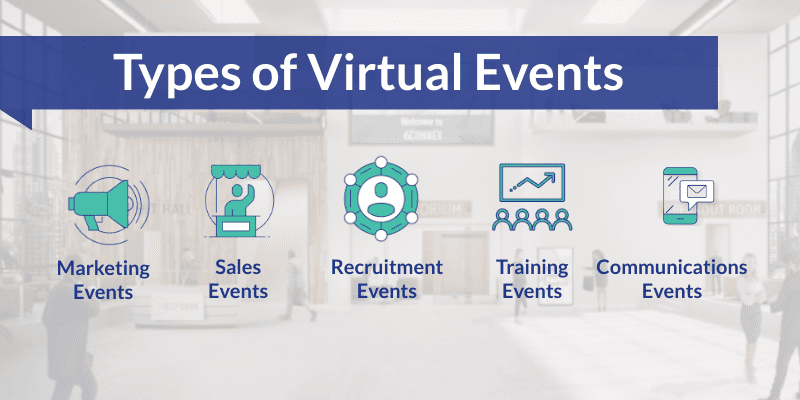
Whether you host virtual events for education purposes or for the dissemination of company information, these environments can be extremely effective in reaching the objective you have for the people you want to reach.
Continue reading to get the full coverage on what a virtual is, the different types of events, as well as the different elements that will bring your virtual program to life.
At a basic level, virtual events are very similar to physical events. They enable groups of people to come together to learn, discuss, and interact. Virtual attendees consume content, exchange contact information, and can even receive training or learn new material the same way you would in a classroom setting.
The only difference from the physical is that online events happen through a virtual conference platform where all resources can be conveniently downloaded and people’s interactions or progress can be tracked.
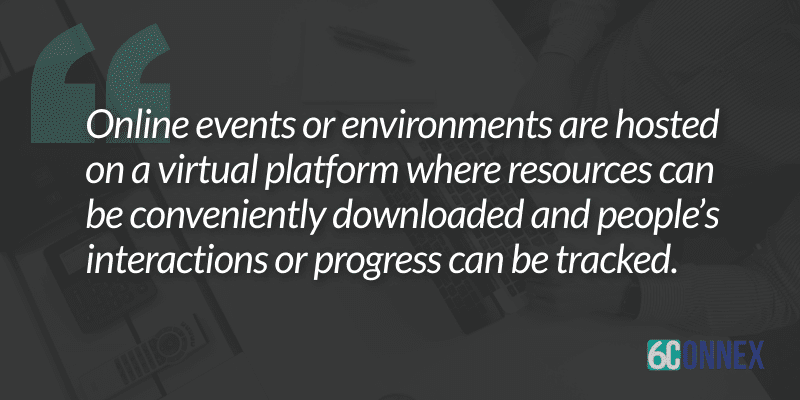
So, what kind of virtual events can you host and what kind of virtual environments can you create?
Educational organizations are adding virtual events to their curriculums to engage students with highly-interactive immersive learning experiences. These e-learning environments can be used for educational content such as:
With supreme virtual conferencing tools, the learning opportunities and engagement possibilities are endless – students can take a tour of important landmarks, for instance, or actively participate in discussions about a topic in real-time or on-demand.
Students can delve deep into any subject matter with knowledgeable experts near and far, so location is not a deterrent. With video chat capabilities, students can instantly engage in cultural and social events and meet other students in a relaxed and fun way.
Take administrative control of a student or attendees progress with the following features a virtual event platform offers:
If you are looking for a virtual platform that can host your educational content, learn how 6connex can help.
There are many types of virtual events. Some of the most popular virtual events for for-profit businesses include:
Your imagination can run wild here. As mentioned before, any type of event that requires the attention and engagement of a large audience can be hosted online. For a business, most of the above events fall into the following areas of types of virtual events:
Virtual events are not only reserved for educational purposes or for businesses. There are virtual event opportunities in the non-profit area as well. For instance, non-profits can use online events as a creative marketing strategy for virtual fundraising ideas they want to execute.
All types of organizations can make the most of a virtual event to share information, market to their audience, and accomplish their strategic organization’s goals.
But just how do you do it?
Now that you know the basics of what a virtual event, it’s time to see what one actually looks like and get a feel for how virtual participants would interact one.
In the visual layer, you can include background images and graphics to provide a sense of space and context for the content. Often, visuals are created to look like physical rooms and spaces, making navigation for attendees or students very intuitive.
Using signs for directions and promotion is another way to guide attendees to participate throughout the different parts of a virtual environment.
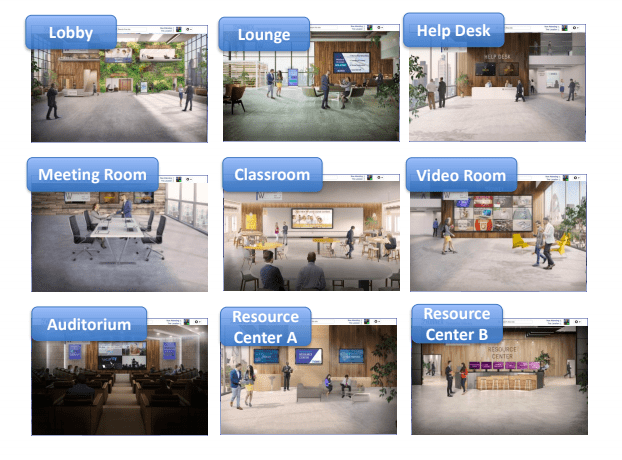
The way your virtual event will look is entirely up to you. For keynote presentations, for instance, you can create a space that resembles an auditorium for attendees to feel like they are watching a keynote speaker in a physical event.
Depending on the audience – and particularly for younger attendees – our virtual events team has noticed a surge in the use of hybrid events. This type of event would not necessarily have to resemble a physical location and simply uses a regular screen for attendees to watch while the virtual event takes place.
Something to consider for future events as you plan for a different kind of audience.
The interactive layer is where actions occur over the visual background. This is where the flexibility and the power of the virtual events software come into play. Some interactive elements virtual attendees can engage in include:
These are just a few activities you can offer for virtual attendees. You can take it to the next level and gamify the experience as well. Games like treasure hunts or fun prize giveaways can be tied to these actions, creating more energy and interactivity for virtual participants.
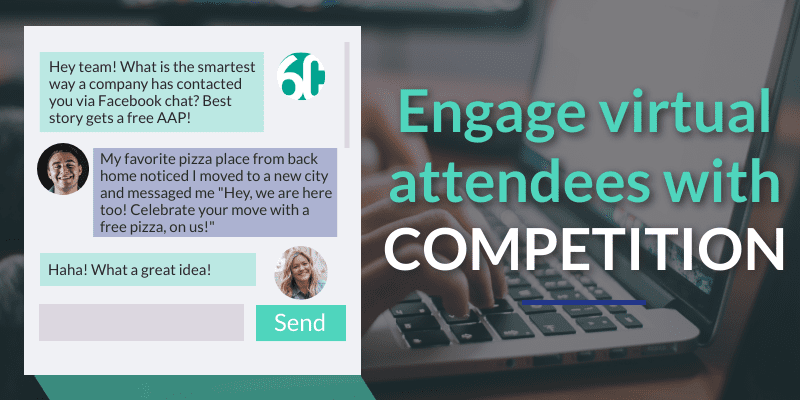
Even when an event is not live, a virtual environment can remain open for anytime access, 24/7, allowing for more opportunities for attendees to participate in an event after-the-fact or for students to continue learning and engaging in their learning environment.
24/7 access gives you 24/7 data to every part of your virtual environment. The data and metrics layer is where every action is tracked for measurable results.
In e-learning platforms, you can track how much a student is learning at any time through the use of real-time dashboards and scheduled progress reports. The reporting and metrics for e-learning opportunities include:
For virtual events, producers can access real-time reports of the interactions at an event or after an event, giving deeper insight into user behavior and content preferences, which translates to ROI calculations and a true understanding of program impact.
This is one area truly unique to online events. Hosting events virtually allows for the valuable data collection of virtual participants in real-time – a MAJOR benefit for any type of virtual event program.
If you want to learn more about types of virtual events, check out our blog for more resources on hosting an online program.
If you are ready to start planning, make sure to choose one of the best virtual conference platforms available to host your tradeshow, e-learning coursework, or certification. Request a 6Connex demo to see how our team can help you execute any virtual event or program.
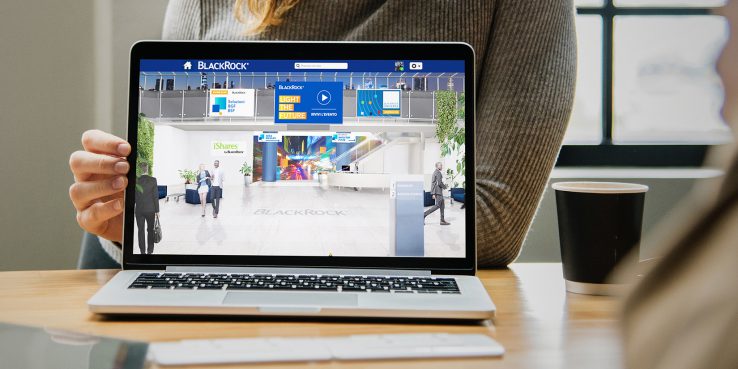
When choosing a job, the benefits package is a large factor for many employees. Even current employees consider their benefits as a pro — or perhaps even a con — if they are ever questioning a job change. But, many employees may not even know the details of their current benefits package.
To resolve this, many companies make it a point to host a benefits fair for their employees. Many employees may feel they don’t have the time to educate themselves on the benefits, or which benefits to choose. On the flipside, several employers may not have the resources or understand how to educate their employees on the benefits they’re offering.
An initial approach to employee education is often printed materials: brochures, packets, and handouts. These could be provided within the office or even at a benefits fair with booths and representatives from different companies involved in the provided benefits.
But what about presenting this information in a place your employees feel most at home? Online.
Believe it or not, many companies spend thousands putting human resource managers on planes all over the world to meet with employees in-person. A virtual setup means saving all of that money, while still having everyone in the same room.
In a virtual benefits fair, employees can visit the booths or watch the presentations that they need and only those. They can download certain information and refer back to it whenever they need it.
Hosting a virtual benefits fair puts people in multiple situations where they feel comfortable — in an online environment, accessing information from wherever they work. This allows employees to better absorb the provided information.
A virtual benefits fair is new and exciting, and getting employees engaged may give them an entirely new outlook on wellness.
No more playing a game of telephone with important information on health insurance. At a virtual benefits fair, employees can ask the questions they need answers for and they can get direct answers from insurance representatives.
Virtual benefits fairs are cost-effective in many ways, from travel, printing, venue rental, etc.
Employers can get statistics on what booths employees visited the most, or what presentation had the most attendance, and this information can help guide future communications.
Because employees can access the fair and any accompanying information from anywhere, it means they can include the people in their lives (whom will likely be affected by the benefits) that matter.
Virtual benefits fairs tend to show employees just how much they mean to their employer, and that’s likely one of the top reasons to host one!
A virtual benefits fair is cost-effective, global, engaging, informative, and it boosts employee morale, among many other things.
One big pro for hosting a virtual benefits fair is that it helps employees feel connected and gives them access to the information they need at any time.
At 6Connex, our platform allows companies to host virtual benefits fairs that look a lot like an in-person benefits fair, complete with booths, presentations, and even an auditorium. Don’t worry, we’re not leaving it up to you to figure it all out, that’s what we’re here for!

Virtual environments are great for saving time and money, while having a broader reach. But the goal for creating a successful virtual environment is to make it engaging for attendees.
The more engagement and interaction you’re able to create, the more your attendees will listen to what’s being presented, retain the information provided, and enjoy the environment you’ve created!
But how? We’ve got eight ways you can make any virtual environment engaging for visitors.
Finding the right platform to host your event is a top priority. Look for a platform that is able to accommodate the event’s needs, including all of the event elements you’re looking for and the number of potential attendees. If the platform has a good team behind it, they’ll also be able to help you build an engaging environment.
If your event plans to have presentations, webinars, or speakers, make sure you choose people that will captivate your audience. Any presenter, webinar facilitator, or speaker is going to be the main focus for your visitors, and this can make or break your event.
If it’s a person you’ve never watched present before, see if they have presentations online you can access to make sure they’re a fit.
Take great care in the marketing for your virtual event so you can drum up excitement. Traditional and digital marketing efforts do apply, but you may also consider giving registrants a sneak peek of event elements. Perhaps you’ll provide an agenda or a preview video of the featured speaker to get attendees really excited about the event.
It’s important to remember that virtual environments are still new for some people, so keep that in mind when you’re designing it. You don’t want people to feel lost or overwhelmed by the environment so much they don’t receive the information you’re putting out there! Make it as a familiar and as easy-to-use as possible.
If possible, go for the live presentation or webinar. Live presenters are more engaging for an audience and they can gauge the room and adjust accordingly. However, if you have to go with a pre-recorded session, make sure the speaker is energetic and exciting to watch.
Of course, technical difficulties aren’t likely to occur, but it’s better to be prepared, just in case. This goes back to tip number one, when you’re choosing your platform. Choose a platform that has great customer service that can help you at any time, especially during the event.
Avoid building a virtual environment only to talk at your attendees with a plain presentation. Make sure to plan engaging events, discussions, and activities. If possible, encorporate video, downloadable collateral, and live chat sessions. Allow areas where participants can talk to each other, too.
Once the virtual event is over, follow-up and ask attendees to provide honest feedback so you can improve for your next virtual event. Depending on the platform you’re using, you can also look at the data from your event to see where participants spent the most time and how they interacted.
Interested in seeing a demo? Contact us today!
You can choose from so many different types of virtual environments, making any of them look as life-like as possible. But there are five elements you must have in your virtual environment to insure it’s a successful one.

There are so many different ways you can approach a virtual environment, from all of the visual elements to downloadable collateral. But there are certain elements you should include in your virtual environment in order for it to be successful. We’ve picked the top five elements you should include in your next virtual environment.
No matter what you’re using your virtual environment for – a career fair, a summit, a training – you must show off great content. This content can be in the form of a presentation, a webinar, or even useful downloads such as recent company press releases or stock information.
If you’re planning on putting any sort of presentation in your virtual environment, utilize effective storytelling to get your message across. Storytelling is often used in marketing and can work very well to get a message across, and also speak to pain points to get qualified leads. With practice (before the event), you can perfect your storytelling capabilities to engage your audience and retain the information you’re presenting.
Just as with an in-person event, you have to work to make sure people are finding ways to interact in a virtual environment. It’s easy for participants to get distracted and wander away from their devices, so you’ve got to keep them on-point! Using presentations, live video, live chat, and networking opportunities will keep participants engaged in your virtual environment.
If you used social media to promote your virtual event, you should continue to incorporate social media into your environment. Encourage participants to use the event hashtag to promote it while they’re participating. Depending on the virtual platform you choose to use, you’ll be able to integrate social media channels into the event so participants are further distracted.
If possible, do include live video into your virtual environment in some form. If you’re planning to have a webinar or presentation, go for a live one instead of pre-recorded (but use pre-recorded video over nothing at all). No matter the capacity, a live presenter is always more engaging than one that’s pre-recorded. Your virtual event team can assist you with any questions or hesitations you have about including live video.
Interested in planning and creating a virtual event? Contact our team today!
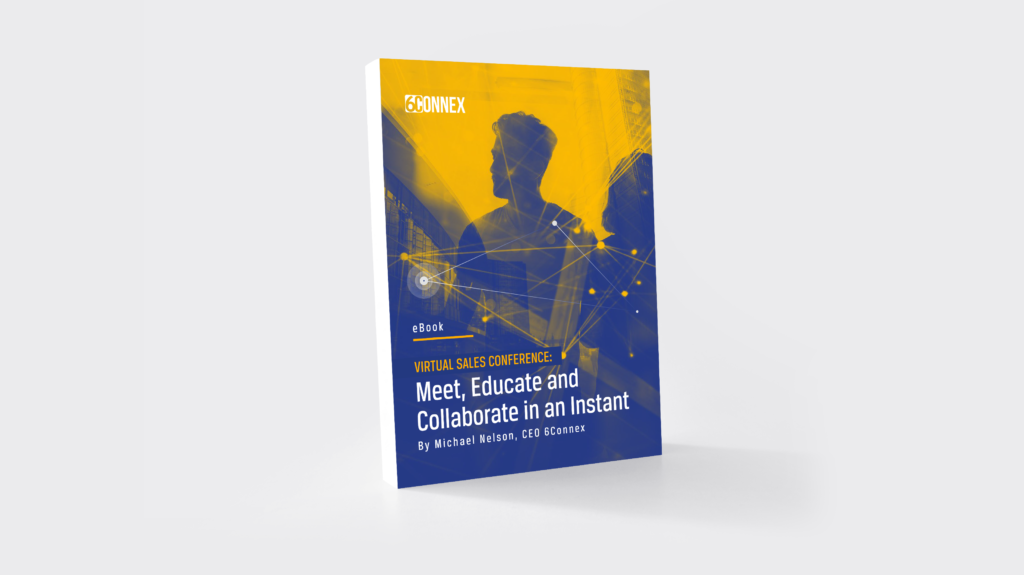
Nowhere else is the saying “time is money” truer than when you are dealing with sales teams. With sales, time is literally used to gain money for your company, as they close deals and grow the revenue of a business. That’s why nowadays, with workforces increasingly moving away from centralized offices and into the home or on the road, sales kickoffs are luckily moving into the digital realm.
Don’t get us wrong, the networking and socializing part of in-person sales kickoffs are great. But unfortunately, those two don’t mix well with learning, and we’ll bet that open bar doesn’t help with knowledge retention either!
By going virtual, the experience enhances the kick-off, with a lot less overhead and money spent to get it done. Virtual SKOs allow for new information, speakers, and important updates to be shown live, and stored for later visits.
So, whether you’re replacing in-person meetings or adding to your educational lineup, virtual is the way to go. By paring your SKO down to the virtual environment, you can expand your reach, lower your expenses and your employees have no excuse not to sell with the best information available.
Want to learn more about Virtual Sales Conferences? Complete the form below to get the full eBook!
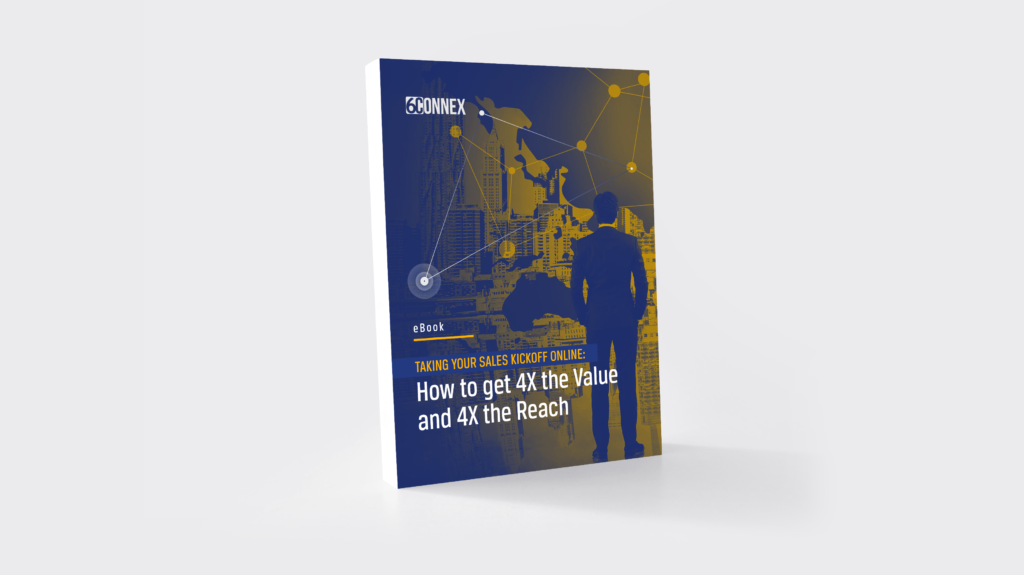
There is no doubt that sales can be considered one of the main lifelines of any business- it’s mostly thanks to the sales team that revenue comes in to keep a business profitable. Which is why sales kickoffs (SKOs) are so important. Nowadays, companies use them to give their sales reps the tools and motivation they need to divide and conquer for the upcoming year. Although unfortunately, sales kickoffs can sometimes be inefficient for businesses when they’re done in-person.
That’s mainly because many organizations still fly their entire sales team to locations across the nation or the world to teach them about new tools, programs, and to have trainings together every year. From guest speakers, entertainment, travel expenses, and accommodations, these conferences can become very expensive; and sometimes not very effective. Research shows that salespeople lose 80-90% of what they learn after just one month, diminishing the long-term value of an expensive event down to… virtually nothing. This can lead to the question, ‘where did my money go?’
But don’t panic, we have good news: the new strategy for sales enablement is here… and it’s virtual! By going virtual and having your SKO in a digital platform, you can save money while simultaneously improving what the purpose of the SKO really is – to train, to learn, and to sell more.
Want to learn how to get 4X the value and 4X the reach by taking your sales kickoff online? Download the full eBook.
New Year, new marketing strategies.
The creative senses of marketers everywhere are tingling with innovative ideas to add value and generate leads this year. Virtual conferences are popping up everywhere as more B2B & B2C marketers are discovering their inherent value.
Unlike in-person events that go deep into topics with only a few select individuals, online events allow you to reach a large pool of self-qualified leads while offering them valuable content that they can digest at their own pace.
But how exactly can you pull off a massive lead-generating and value-driven event?
In this article, we share virtual event best practices and inside scoop on how to successfully create a lead-generating summit in 2019!
To the drawing board! Wonderful, you’ve decided to plan your first virtual event. First, you need to lay a foundation that will attract the best speakers and most qualified attendees through your vision.
When setting your vision, make sure you have the answers to these questions:
Contributing to relevant, cutting-edge topics while using innovative platforms is great for branding and even potential sales for your conference. To organize your vision when planning your virtual conference, check out our virtual event tip sheet here!
If you are the host, attendees will remember your brand and associate the theme with it. Make sure the topics you choose align with your values and service to promote stream-lined brand awareness.
How much time does it really take to plan out all of the aspects of a virtual event? Check out our virtual summit timeline tips from experts and download the relevant tools.
Even though the majority of attendees will only sign up a couple of weeks before your event, that doesn’t mean you can put off your planning! Kara Widdison, Marketing Manager at Snapapp, told us that her first virtual conference with 6Connex took 2-3 months of planning to execute. Marketo estimates that the time it takes to run larger virtual events can be up to 4-6 months.
Use a virtual conference project management tool like Trello to track your progress and goals. Click on the link to see all of your goals lined out over a 3-month period.
Not only do quality speakers make your event more valuable, but they also allow you to crowdsource your marketing efforts. We cover how you can attract the best speakers to your online conference by being mindful of the vision you cultivate, your onboarding process, and the incentives you offer!
In order to get great speakers for your virtual conference, you need to get your vision set. You can save time and money promoting your event by reaching out to speakers who
Speakers will want to contribute to your online event if they feel that your vision aligns with their own brand for their own marketing and professional goals. They will naturally promote your event and bring their following with them.
But how do you secure quality speakers for your virtual conference?
The one thing we know for sure about thought leaders in your industry is that they are extremely busy. Some speakers are skeptical about agreeing to speak because they don’t know how much of a time commitment it will be. If you use an awesome e-mail template and offer to create their promotional material, you can make onboarding a breeze for potential sponsors.
One way to make virtual events exciting is by gamifying the experience. Challenge speakers or sponsors to some friendly competition by telling them that whoever brings the most attendees will win top prizes! You can facilitate this process by creating each speaker an individual virtual event landing page for sign-ups and by providing them with social media copy and visuals to launch their promos! Let the games begin!
Remember This!: People will sign up for your virtual event because they want access to valuable content or to get closer to industry leaders in a no-strings-attached environment. Make sure to let your speakers know that they shouldn’t pitch directly to attendees to avoid any awkward situations.
Your awesome event is in the incubator! Now, to make your online event irresistible, you need to make sure your landing pages and informational pages excite your users to smash the registration button.
Your virtual event landing page is bottom of the marketing funnel material. It should be sharp and aesthetic enough to convert both speakers and attendees. The page should highlight the benefits of attending.
Hubspot’s virtual event experts suggest adding agenda and session pages as well. In a separate URL post the agenda of the event and for additional converting content you can include session pages with speaker’s bios and short videos explaining what they will cover.
Teaming up with industry leaders gives you access to their loyal followings. Make sure to make it as easy as possible for them to collaborate and post about your event. Get your marketing hats on and follow these tips to promote your event!
Start creating a pipeline of promotional marketing material and offer it to speakers to exponentially increase your reach.
Research blog posts related to the topics each speaker will cover. Then, create SEO proofed copy that you can give speakers to post for free. You can also write them e-mail drips and social media posts.
To facilitate the posting process (and to make sure it’s not overwhelming their subscribers) you can create a content calendar for them with posting dates, graphics, and times. The easier you make it for them, the better for your event and your brand in the long-run.
You can send out as many invites as you want several months in advance, but because virtual events don’t require attendees to book flights or accommodation, they won’t know their availability and simply won’t bite. If possible, try to funnel the bulk of your marketing material out a couple weeks before the event up until the launch date.
When attendees sign up and you get that self-qualified lead in hand, add a Google question submission form so that you can use their inquiries to help guide conversations. This bonus tip also increases UX and shows that you are trying to provide the most value possible.
Measure twice, launch once! Here’s your countdown list for the week of your virtual event!
Have a chat with speakers to make sure that you are on the same page and that they are more than comfortable using the software.
The big moment has arrived! Check all landing pages to make sure there are no bugs in the system. It is also a nice touch to send out a reminder e-mail to those who registered to build up hype and secure attendance.
Send out a pre-scheduled notification to speakers letting them in it’s time to shine!
Social media posts should also be monitored. You can have an interactive slideshow at your virtual event to showcase those who post and hashtag your event. If you’re being tweeted at in real time, make it interactive!
Finally, on a more technical note, stay on top of e-mail to see if any users are having technical difficulties.
So, you have the number of attendees and a solid e-mail list. Now what? Put that empirical evidence to good use to get the most ROI from your virtual conference.
Make note of the content views, volume and value of transactions performed, download volume, and the number of interactions with the staff. Analyze this data to gauge the quality of the leads generated and pass it on to your sales team. You can use participation spikes to nurture leads by creating content that your users find useful.
Find a virtual conference platform provider that offers intuitive tracking tools or you’ll miss out on a great data generation opportunity. Use data tracking to identify hot leads and disqualify others so that you can focus your efforts on putting the right users down your sales funnel. Don’t worry, 6Connex has you covered with top-of-the-line tracking capabilities.
If quantity and reach are your goals, then it is definitely time for virtual events.
Click here to see how 6Connex can offer you more resources to get your virtual conference off the ground!
I think that we could write an article about the pros and cons of charging entrance for a virtual event and eventually include it in this section as something to consider.

You’ve heard correctly: Virtual events generate tons of leads.
While virtual summits offer the traditional benefits of trade shows (accelerating brand awareness and marketing your product/service), they also cast a larger net to your pool of prospective clients, have fewer time restrictions, and improve the quality of leads through data collection. It also doesn’t hurt that they save you a big chunk of change and time in the process!
Here is our step-by-step guide on how to launch a virtual event for lead generation so you can get a head start on planning yours today!
Here, we break down the areas you need to focus on to launch a successful virtual event with the goal of generating more leads.
To create lead generations, you first need an audience. Use the following tip to design a dynamic virtual event that incites participation from both sponsors and attendees.
Knowing the vision for your summit and the number of potential attendees is indispensable to have when approaching speakers and/or sponsors.
*Insider Tip: Pre-registering attendees will be a good selling point to speakers so you can give them an indication of their potential reach.
If attendees have registered for your virtual summit, you already have a list of qualified leads to pull from. This means, you better bring your sales A-game. Try the following sales-minded preparation when planning for your virtual summit:
Virtual events trump brick and mortar events because of their inherent accessibility and low barriers of entry. Capitalize on this for more lead generation by doing the following:
Lead generation continues long after the event closes its virtual doors. The data collected at virtual summits and conferences can help you nurture current leads and generate future ones. Here’s how to actually use it!
Here’s the biggest perk: Your event doesn’t have to be limited to just one day. Here is how going virtual enhances your engagement and boosts your possible leads.
Time restrictions are non-existent when you go virtual – you just have to choose what style best represents your brand.
Now that we’ve learned all about how virtual events can generate quality leads and sales, are you ready to make the most of virtual events? Here are your next steps to a successful event: